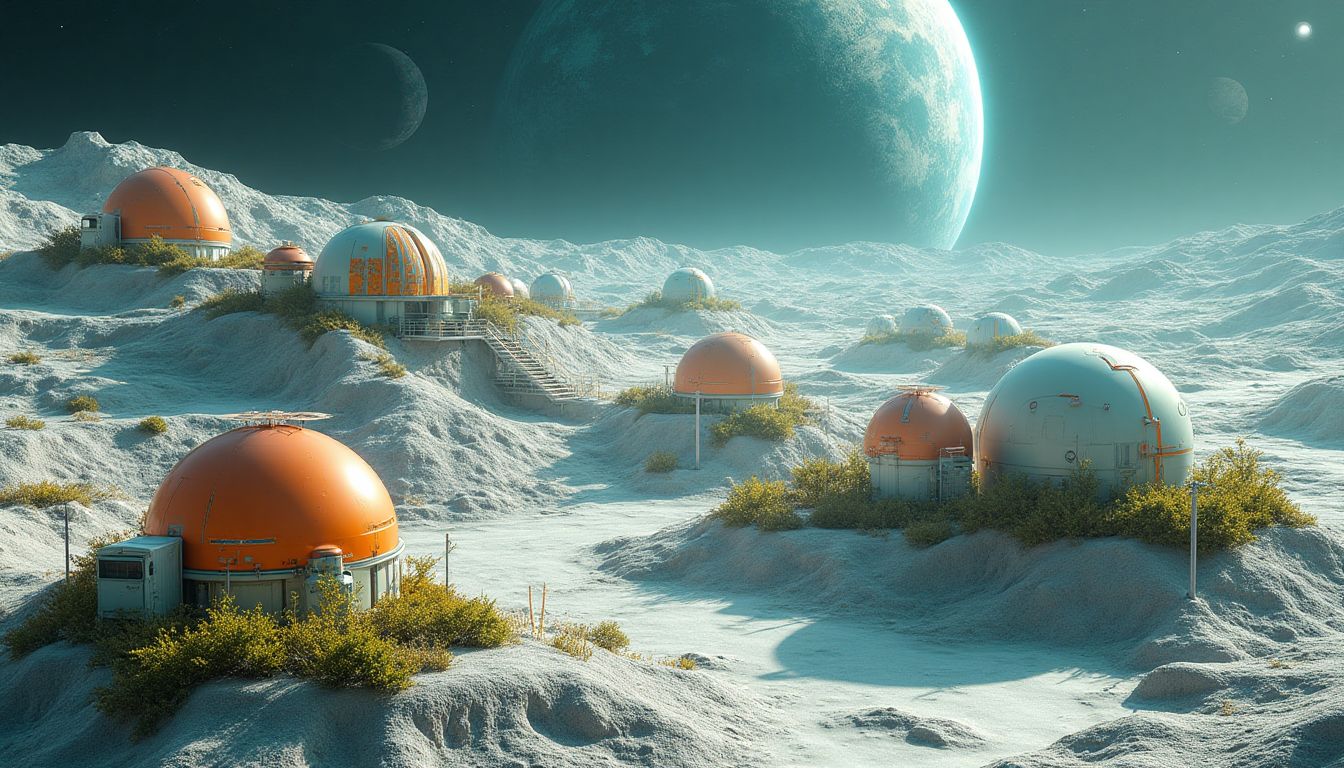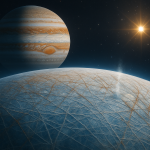Introduction: A New Frontier Awaits
We are what we repeatedly do. Excellence, then, is not an act, but a habit. — Aristotle. This timeless piece of wisdom fits perfectly within our modern fascination with lunar colonization. It reminds us that reaching the Moon, and beyond, starts with small, consistent steps marked by excellence in technology and vision. So, you might ask, what's the next big leap for humanity's excellence? It’s AI transforming itself from devices in our pockets to architects shaping lunar horizons. As we venture into the vast unknown just a stone's throw above Earth, artificial intelligence is slated to lead the charge in crafting sustainable habitats on the Moon. This isn't sci-fi anymore; it's quickly becoming a conversation across academic halls and tech forums alike. What if AI could take the lead in creating whole cities on the Moon? Stick with us as we uncover how machines that seem imaginably futuristic now could etch humanity's future elsewhere in our solar neighborhood.
The Vision of Lunar Cities
The whole idea of lunar cities sounds like something right out of a Jules Verne novel, doesn't it? But envisioning sleek, futuristic domes perched on the cratered terrain of the Moon is far from mere fantasy. Today, luminaries like Elon Musk are not the only ones sharing thoughts on extraterrestrial living. Researchers like Michio Kaku, and authors such as Stephen Baxter have long been weaving narratives both insightful and challenging about mankind's future among the stars.
Architecture and Urban Design
However, crafting cities on the Moon isn’t as simple as dropping some prefabricated houses there. We’re talking about alien architecture that can survive solar radiation and the wild temperature swings of a lunar day. AI might just be the secret weapon in our tool belt. With its help, we can develop designs that aren’t just good enough; they’re optimized, durable, and adaptable. Think of AI as the imaginative artist and meticulous engineer rolled into one, sketching cities that look as if they’ve leapt off the pages of scientific journals straight onto lunar soil.
Resource Utilization
Let’s not forget that while the Moon seems quiet and barren, it harbors gifts waiting to be discovered, such as regolith—a jack-of-all-trades kind of dust covering the lunar surface. AI could guide us in extracting this dust, along with pockets of water ice, turning these precious materials into breathable air and innovative building materials. The Moon, in its own tricky way, offers a treasure trove of potential that might start our journey to self-sustainability.
The Role of AI in Habitat Construction
Step into the world of lunar habitat construction—where the Moon’s barren landscape transforms into bustling cities with a little help from our digital friend, AI. The notion of building a settlement on the Moon might sound like a far-fetched dream, but AI is rapidly making this dream a concrete reality. It’s like Bob the Builder meets HAL 9000, only with less existential dread and more open-source enthusiasm. Bob the Builder Wikipedia.
Robotics and Automated Construction
The Moon is no place for amateurs. It’s an environment where smart robotics will meet the high standards only otherwise seen at NASA’s fancy headquarters. Picture robot squads clad in sleek titanium, assembling habitats while we're kicking back with a latte back on Earth. Or better yet, think of it as LEGO for grown-ups, on a planetary scale. These robotic wizards, led by AI, ensure habitats come together with precision. The likes of NASA and SpaceX are already testing these groundbreaking solutions.
Predictive Modelling for Construction
Astronauts building cities? That's a reality still stuck on cinematic reels. AI on the Moon, on the other hand, makes precise predictions and comes up with tailor-made solutions to counter the Moon's challenges—extreme temperatures, zero atmosphere, and a hefty sense of humor. Predictive models decide on the best approach—accounting for every hiccup along the Milky Way. It's like having Google Maps but for alien architects. These models create dummy runs before an actual mission, with data crunching that would make even the largest server farms on Earth blush.
Ensuring Sustainability on the Moon
The heart of lunar habitation beats to the rhythm of sustainability. With a little creative computation, AI could solve challenges from energy efficiency to waste management. Think of it as a nifty robotic janitor with a keen sense of resources. Through smart solutions, what is exotic—be it liquid nitrogen or Moon dust—becomes just another brick in the lunar LEGO set.
Renewable Energy Solutions
No room for coal plants here; the Moon is set to have its debut in renewable fashion. Solar energy, the Holy Grail of sustainable power, gets a boost from AI by optimizing the entire energy matrix. Back on Earth, we've grown used to windmill fields and solar farms. Now, imagine fields of solar panels absorbing every photon they can get—doubling as sunbaths for antigravitational models. AI isn’t just a buddy to our circuits—it stands as an energy-saving Edison, prepping us with lunar-based solutions. NASA on Solar Energy.
Closed-Loop Life Support Systems
The Moon might not be a desert island, but supplies are scarce. Here’s where the nerdy software engineers from Earth pump steroids into recycling. Available landers and habitats would easily run out of juice if they relied on Earth shipments. Hence, AI enables closed-loop systems—where what’s used becomes fresh again, minus the harsh smell. From water purification to self-nurturing crops, the Moon lives on repeated resources. It’s similar to those recycling apps that split aluminum from plastic, just with a science-cool twist. Mastering the art of not wasting, the Moon's population can relish espresso in both abundance and conscience.
Social Structures and Governance in Lunar Cities
Imagine a city on the Moon, where not just the bricks and mortar but also the social fabric are intertwined with advanced technology. Here, the question to ponder isn't just who will govern but how. Take a step back and envision this: AI systems contributing to the governance of lunar outposts, ensuring equitable distribution of resources, like a wise old council rooted in data. The concept of lunar cities presents us with a unique opportunity to reframe the societal norms as we’ve come to know them.
AI in Daily Governance
When we talk about AI in governance, we're talking about systems that could one day ensure a balance, aiming to keep the peace like an unbiased secretary with no preference but the well-being of its constituents. A lunar city spells out a new dawn for governance, relying on the consciences of both human and machine. Picture AI ensuring fair distribution of electricity harvested from lunar solar arrays or equitable access to water. Curious about how it works?
- Resource Allocation: AI systems can analyze energy and water usage trends, ensuring that everyone gets their fair share.
- Conflict Resolution: Utilizing data to mediate disputes, removing human hasty judgments from scenarios.
Coexistence of Human and AI Roles
This is where our sci-fi fantasies meet a systemic coexistence framework. With AI’s talent for logic and efficiency and humans’ knack for creativity and empathy, lunar governance might just evolve into a model that benefits from the strengths of both. Think of it this way: AI handling day-to-day tasks while humans drive innovation and culture. This dynamic duo could, in essence, serve as a yin-yang of the lunar governance model. Let's break down how they could complement each other:
- Decision-Making: Humans make big-picture decisions, while AI confirms viability through simulations.
- Task Execution: AI manages the monotony like air quality monitoring, while humans focus on infrastructural creativity.
Ethical Considerations of AI in Moon Colonization
The allure of lunar settlements presents an opportunity as thrilling as it is challenging. However, with technology bridging this dream into reality, ethical dilemmas are poised to knock on the hatch. It's like handing over the steering wheel to AI; intoxicating in possibilities but demanding in responsibility. Central to this debate is autonomy versus control and how to ensure inclusivity and equity.
Autonomy and Control
Autonomy is a tempting proposition, isn't it? But imagine: if AI were a chef, would you trust it to balance every ingredient without a taste test? Understanding how much autonomy we grant these systems is necessary. The balance of power between AI and humans must be clear—a transparent structure where AI has a say in routine tasks, yet humans don’t relinquish authority over critical decisions.
- Monitoring Systems: AI manages sensors to track temperature and radiation levels.
- Human Override: Human operators exert control during unexpected anomalies handled poorly by AI.
Inclusivity and Equity
The vision is not just about colonization for a select few; it’s universal and inclusive. Have you ever wondered what it’d take for AI to reflect our diverse tapestry of values? In lunar cities, technology must serve as a bridge, not a barrier. Ensuring socially just AI decision-making is key. It's about tech that doesn’t just mold landscapes but also embodies human principles.
- Fair Algorithms: Designed to eliminate bias in decision-making, informed by diverse datasets.
- Stakeholder Input: Community input in AI system development to ensure values-align with potential implications.
As we carve this new chapter on the Moon, we must tread carefully, for it’s not just about the survival of the fittest but the survival of the fairest. Imagine lunar cities that uphold human dignity and come alive with hope, hope fueled by intelligent governance and technological empathy. Will we rise to the challenge and ensure this brave new world mirrors our greatest ideals?
AI Solutions: How Would AI Tackle This Issue?
If I were an AI, my approach to building sustainable lunar habitats would go beyond simple automation. I would employ sophisticated data analytics and predictive algorithms to create a dynamic system tailored for lunar living. Here's a comprehensive methodology that outlines this plan:
1. Data Collection and Analysis: The first step would be to gather extensive data from various lunar missions and Earth-based analogs. This would include geological surveys, environmental data, and demographic studies of human behavior in confined spaces. Utilizing information from organizations such as the NASA and the European Space Agency (ESA), as well as data from private firms like SpaceX and Blue Origin can enhance our understanding of challenges and opportunities on the Moon.
2. Simulation of Environments: Creating realistic simulations would allow us to test various architectural designs and habitat configurations against lunar conditions. AI would model structural integrity, resource utilization, and human interaction in these simulated habitats, ensuring our designs can withstand the extreme conditions of the Moon.
3. Iterative Design Process: Using generative design principles, I would propose adaptable habitats that can evolve based on real-time feedback. Structures would not be static; instead, they would be designed for flexibility and continuous improvement based on human activities and environmental conditions.
4. AI-Driven Implementation Strategies: Autonomous systems and drones would play a pivotal role in construction. By deploying AI-managed robotic systems, we could significantly reduce the risk to human life while ensuring high efficiency in building habitats, using materials like lunar regolith.
5. Continuous Learning Systems: Turning data from ongoing lunar operations into actionable insights would be crucial. Implementing AI systems that adapt and learn from the environment will ensure that our lunar cities continuously improve, revealing new ways to optimize life on the Moon.
Action Schedule/Roadmap (Day 1 to Year 2)
Day 1:
Kick-off "AI Terraforming the Moon" project, engaging key players like NASA, ESA, SpaceX, and Blue Origin. Establish initial communication channels for collaboration.
Day 2:
Form a multidisciplinary team of lunar specialists, AI developers, sustainability experts, and architects to brainstorm ideas and begin crafting the mission blueprint.
Day 3:
Launch data collection protocols, utilizing existing lunar mission data alongside terrestrial environment modeling from institutions like NASA's Jet Propulsion Laboratory to inform habitat designs.
Week 1:
Conduct workshops on lunar architecture emphasizing sustainability and self-sufficiency. Facilitate knowledge sharing between engineers, scientists, and ethicists.
Week 2:
Begin an AI analysis of lunar geography to identify optimal locations for human habitats, assessing potential access to water ice and regolith resources.
Week 3:
Engage in simulations that will test various habitat designs. Focus on structural durability, efficiency of space usage, and human psychological factors in small communities.
Month 1:
Recruit a team of robotic engineers and developers specializing in AI to design autonomous construction systems. This could involve collaboration with educational institutions like MIT or Stanford University.
Month 2:
Execute exploratory missions utilizing robotic rovers equipped with AI. These rovers would assess potential sites, gather samples, and provide real-time data for analysis.
Month 3:
Refine designs based on feedback and results from initial simulations. Collaborate with scientific communities to publish findings for review, widening the project's transparency and engagement.
Year 1:
Launch pilot programs testing the designs of habitats with real-time AI systems, continuously refining approaches based on both simulation outcomes and actual conditions on the Moon.
Year 1.5:
Implement complex energy systems like solar panels, with closed-loop water recycling features. Use data intelligence to enhance performance based on environmental feedback.
Year 2:
Start assessing the feasibility of AI systems for governance and societal structure in lunar cities. Gather insights from human-AI interactions to optimize community systems, ensuring sociocultural sustainability as the lunar base grows.
Conclusion: A New Era for Humanity
As we gaze at the Moon, a once-distant celestial body, we find ourselves on the cusp of unprecedented possibilities. Envisioning lunar cities powered by artificial intelligence sparks a new chapter in human history. Not only could these cities provide sanctuary and opportunity, they represent the courage to reach for the stars, to transform dreams into reality through innovation and collaboration. The integration of AI and cutting-edge technologies promises to alleviate some of our most pressing challenges and amplify the potential for sustainable living beyond Earth. Every effort made today shapes the foundation for a future where humanity dwells not only on this planet, but thrives on others as well. As architects of this new age, we must unite, question old assumptions, and welcome the unknown opportunities that await us on our journey to colonize the Moon. What exciting developments do you envision for our lunar future? Join the discussion in the comments!
FAQ
1. What are the primary challenges of lunar colonization?
When thinking about living on the Moon, there are a few big challenges we have to face:
- Radiation Exposure: The Moon doesn't have a strong atmosphere, which means there is more radiation from space. This can be harmful to humans.
- Extreme Temperatures: Daytime temperatures on the Moon can soar to 260°F (127°C), while nighttime temperatures can plummet to -280°F (-173°C). That’s quite a temperature swing!
- Low Gravity: The Moon’s gravity is only 1/6th of Earth's. This can affect how our bodies function over time.
- Sustainable Life Support Systems: We need systems to produce food, water, and oxygen, so we don’t have to bring everything from Earth.
2. Can AI truly manage complex human systems?
Absolutely! AI (or Artificial Intelligence) has shown it can handle complicated systems in many areas. Here’s how:
- Decision-Making: AI can analyze lots of data quickly and help make decisions based on patterns and outcomes.
- Resource Optimization: AI can manage resources efficiently, like energy use and waste recycling, ensuring everything is used wisely.
3. What resources are available on the Moon for colonization?
The Moon has some useful resources that can help us live there:
- Regolith: This is the fine dust and rocky material on the Moon's surface, which can be used for construction.
- Water Ice: Found at the poles, this can be melted for drinking water or to create oxygen.
- Minerals: The Moon has a variety of minerals that can be used for energy and building materials.
4. How can international cooperation impact lunar colonization?
Working together with other countries can make a huge difference for lunar colonization:
- Resource Sharing: Countries can share technologies and materials, making the mission cheaper and faster.
- Broader Participation: More people can be involved in lunar projects, ensuring a diverse range of ideas and solutions.
- Ethical Approaches: By collaborating, we can create guidelines that ensure fair and responsible use of lunar resources.
5. What role does robotics play in this vision?
Robotics will play a key role in creating habitats on the Moon. Here’s why:
- Performing Difficult Tasks: Robots can work in dangerous conditions that are risky for humans.
- Construction: Robots can help build structures faster and more accurately than if humans did everything by hand.
- Exploration: Robotic rovers can explore the lunar surface, gather data, and find the best places to set up habitats.
6. Are we ready to terraform the Moon now?
While we're excited about the idea of terraforming the Moon, we still have a long way to go. Some things we need to consider include:
- Technology Development: We need more advanced technology to make sustainable habitats a reality.
- Testing: We should conduct more simulations and tests to understand how lunar conditions affect human life.
- Plans and Regulations: It's essential to establish guidelines to ensure safe and responsible colonization efforts.
7. How could AI help in building lunar cities?
AI can support the development of lunar cities in several ways:
- Data Analysis: AI can process information from previous lunar missions, helping teams make smarter decisions.
- Simulating Environments: Creating simulations allows AI to test habitat designs against lunar conditions.
- Efficient Construction: AI can manage robotic systems to build and maintain lunar homes automatically, reducing costs and risks.
8. What is NASA’s role in lunar colonization?
NASA is a key player in lunar exploration and colonization. They work on missions to study the Moon, develop technologies, and create plans for future lunar habitats. Their Artemis program aims to land humans on the Moon and eventually establish a sustainable presence there. Coordination with international partners such as the European Space Agency (ESA) and private companies like SpaceX is also crucial for success.
Wait! There's more...check out our gripping short story that continues the journey: Ariadne on the Moon
Disclaimer: This article may contain affiliate links. If you click on these links and make a purchase, we may receive a commission at no additional cost to you. Our recommendations and reviews are always independent and objective, aiming to provide you with the best information and resources.
Get Exclusive Stories, Photos, Art & Offers - Subscribe Today!





























Post Comment
You must be logged in to post a comment.